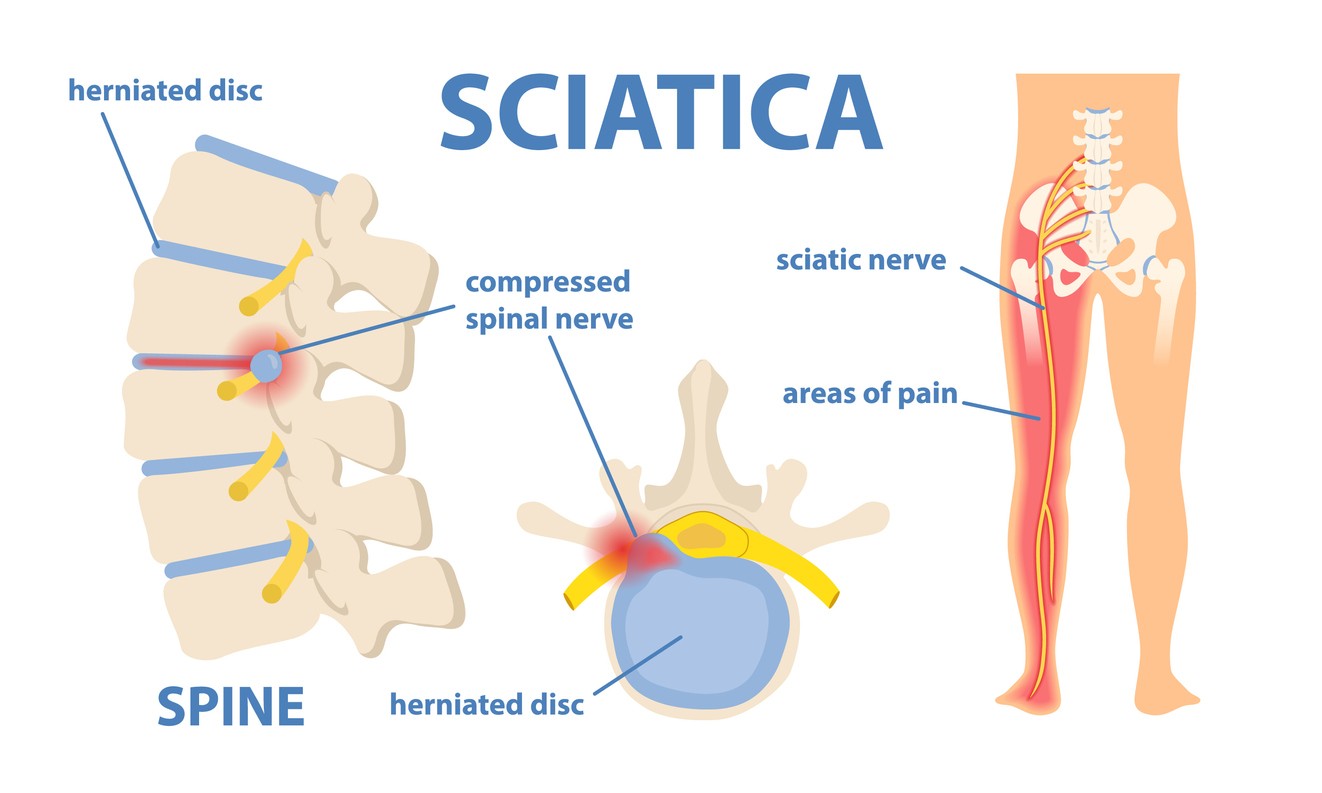Can a Chiropractor Help with Sciatica?
Did you know that pain in your leg or even your foot can be linked directly to your back? Many times, this discomfort is classified as sciatica. More than 40% of people will experience this common condition. While it can resolve independently, non-invasive treatment options like chiropractic care ensure complete resolution and help prevent recurrence.
Keep reading to learn the symptoms, causes, and how chiropractic care can ease your sciatic nerve pain quickly and effectively.
What is Sciatica?

Sciatica describes the pain you experience from a pinched sciatic nerve. It represents a symptom of an underlying problem, not a condition. The sciatic is the thickest and longest nerve in the body, starting in the lower back, traveling through the hips and buttocks, and finally spanning down the back of each leg. It is responsible for sitting, standing, and other sensations.
While the sciatic nerve ends just below the knee, it branches into smaller nerves affecting the legs, feet, and toes. This connection is responsible for the radiating or shooting pain you feel in seemingly unrelated areas.
Sciatica Symptoms
Sciatica pain can occur anywhere along the body’s largest nerve pathway. Most often, it only impacts one side of the body. The sciatica symptoms can vary by case. For example, some sciatica patients may feel constant pain, while others deal with intermittent episodes. The discomfort can come on suddenly or grow gradually.
If you are dealing with sciatica, you may feel mild to severe symptoms, including:
- Numbness
- Muscle weakness in the legs
- Burning
- Deep aching
- Tingling or pins-and-needles sensation
- Shooting pain, like an electric shock
- Lower back pain
These symptoms may worsen after coughing, sneezing, or sitting for long periods, as it compresses the spine and can irritate the sciatic nerve. If your symptoms become severe or chronic, it is necessary to seek treatment. Left untreated, you may experience permanent nerve damage, which can cause a loss of feeling or an inability to control your bowels or bladder.
What Causes Sciatica?

Sciatica can be tied directly to irritation, inflammation, pinching, or nerve compression.
More than 90% of cases of sciatic nerve pain stem from herniated disc. Spinal discs are comprised of cartilage that cushions the vertebrae. Certain situations can cause these discs to spill or bulge out of place, where they put pressure on the nerve.
Herniated disks may also signal degenerative disc disease. As you age, the discs can lose fluid and thin out, bringing the vertebrae closer together and compressing the surrounding nerve.
You are more likely to experience sciatic pain if you are:
- Older– Natural wear and tear on the spinal column increases the chance of bulging or herniated discs.
- Overweight– The extra weight can put stress on your discs.
- An active laborer– Lifting heavy objects and excessive twisting can cause nerve compression.
- Sedentary worker– Sitting for prolonged periods can irritate the nerve roots, as with office workers and long-distance drivers.
- Osteoarthritis– This common condition can cause bone spurs. Like herniated discs, the overgrowth of vertebral bones can press on the sciatic nerve and cause pain.
- Diabetic– Poor glucose regulation can cause nerve damage.
- Injured– Injuries along the spine may lead to inflammation or irritation that impacts the sciatic nerve.
Other situations, like stress, poor posture, and activity levels, can cause muscle fibers and their surrounding structures to contract. Over time, a trigger point or “knot” can form, which may pinch the sciatic nerve.
Piriformis syndrome can also irritate the sciatic nerve and cause similar pain, such as numbness and tingling from the lower back down through the feet. However, this condition results from muscle spasms in the small piriformis muscle located in the buttocks, so it is not technically a cause of sciatica.
Chiropractic Treatment of Sciatica

Chiropractic care is considered a safe and effective treatment option for sciatica. It can actually provide adequate relief for multiple forms of back pain. Your chiropractor works to fix misalignments in the spine, also known as subluxations. This process removes pressure from the spinal cord and increases your mobility, allowing you to return to the activities you enjoy pain free.
Your chiropractor can treat sciatica in a few ways:
- Spinal adjustment– Chiropractic adjustments help restore proper alignment in the affected area and the whole spine. This therapy physically releases any nerve compression and encourages optimal nervous system function.
- Spinal Decompression– Your chiropractor will use a traction table or another motorized device to stretch your spine. This process creates a vacuum effect in the spinal column to retract bulging or herniated discs that affect the sciatic nerve.
- Myofascial release– This physical therapy involves sustained pressure on the trigger points pinching your nerves. This action helps relax contracted muscles for instant pain relief.
- Electrical muscle stimulation– This treatment option sends gentle, non-painful shocks to the affected area, which helps in two ways: releasing feel-good endorphins and blocking painful nerve signals.
During your initial appointment, your sciatica chiropractor will conduct a physical examination and discuss your medical history to determine the best treatment option.
They will also build a custom schedule to treat your sciatica symptoms over multiple visits. While you may feel pain relief after the first appointment, it can take about four chiropractic appointments to resolve your sciatica symptoms completely.
Your treatment plan may also include at-home exercises, cold-hot compress, massage therapy, and lifestyle adjustments to prevent recurrent symptoms.
6 Benefits of Chiropractic Adjustments

Your chiropractor uses spinal manipulation and other techniques to care for the whole body, not just the affected area, so you’ll experience several additional benefits:
1. Reduced Inflammation
Chiropractic techniques can help significantly reduce swelling and inflammation in problem areas. Evidence suggests that it helps lower the production of the neuropeptides and cytokines that regulate the immune response. These elements can exacerbate the immune response, causing ongoing swelling and irritation.
Spinal adjustments can encourage blood flow to the affected site to promote healing.
2. Pain Relief
Back pain is the third most common reason for doctor visits each year. Regular chiropractic care can treat this pain and even prevent its occurrence in the first place. It helps ease tensions and misalignments within soft and hard tissues that can cause discomfort.
Additional therapies, like the Graston technique and shockwave therapy, can even restart the healing process on old injuries and uncomfortable pockets of scar tissue. It can successfully address neck pain, chronic pain, and other problems with near-immediate results. Many patients report feeling better as soon as the first visit.
3. Easier Pregnancies
About 50-80% of pregnant women deal with low back pain and sciatica symptoms. These problems often result from the added weight in the midsection. Pregnancy hormones also cause ligaments to loosen and stretch.
Chiropractic adjustments balance the pelvis, which may make labor shorter and easier. Improving posture can also offer instant relief for expectant mothers. Continuing your routine after delivery can even assist with recovery, ease pain from strange positioning during breastfeeding, and rebalance hormones.
4. Improved Posture
Spinal misalignments, especially when caused by sitting, can worsen sciatica symptoms. Even if you visit a chiropractor once to improve your posture, your body will likely return to its initial state of misalignments and discomfort.
Regular visits can train your spine to remain in its optimal position and help you hold onto your spinal adjustments longer. When your spinal cord and joints are aligned, you experience greater overall health. Unobstructed, your brain can communicate adequately with the rest of your body.
5. Affordable Treatment
Chiropractic treatment is much more affordable than traditional medical visits. More insurance companies are even starting to cover these services. If your insurance does not cover your treatment, you can use your FSA and HSA to pay for any out-of-pocket expenses. The Total Body Chiropractic staff will work to maximize your treatment plan according to your budget.
Not to mention, the treatment duration is typically shorter than more conventional methods. While you may have multiple weekly visits initially, you will shift to a bi-monthly maintenance schedule after your sciatica symptoms have greatly improved.
6. Reduces Reliance on Medication
Those with chronic pain often receive prescriptions to manage their pain. These medications can become addictive and simply mask the pain. On the other hand, chiropractic care addresses the root cause of your pain and initiates the healing process.
Book Your Appointment Today!
The chiropractors at Total Body Chiropractic & Acupuncture in Bend are fully equipped to treat your sciatica—no matter the cause. We will work together to build a custom in-office and at-home treatment plan that not only resolves your lower back pain but also boosts your overall health and wellness. After all, aligning your spine is the key to feeling your best! Schedule your appointment today.

